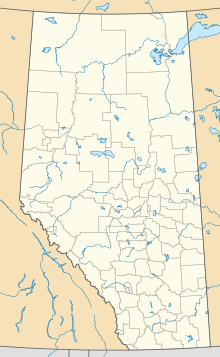Nisku
Nisku | |
|---|---|
 | |
Location of Nisku in Alberta | |
| Coordinates: 53°20′00″N 113°32′00″W / 53.33333°N 113.53333°W | |
| Country | Canada |
| Province | Alberta |
| Region | Edmonton Metropolitan Region |
| Census division | 11 |
| Municipal district | Leduc County |
| Government | |
| • Type | Unincorporated |
| • Mayor | Tanni Doblanko |
| • Governing body | Leduc County Council
|
| Area | |
| • Total | 65.5 km2 (25.3 sq mi) |
| Elevation | 705 m (2,313 ft) |
| Population (2005)[1] | |
| • Total | 30 |
| Time zone | UTC−7 (MST) |
| • Summer (DST) | UTC−6 (MDT) |
| Postal code span | |
| Area code(s) | 780, 587, 825 |
Nisku is a hamlet and an industrial/business park in Alberta, Canada, within Leduc County.[2] It has an elevation of 705 metres (2,313 ft).
The hamlet and industrial/business park are located in census division No. 11 and in the federal riding of Edmonton—Wetaskiwin. The word Nisku means "goose" in Cree.[3]
The Hamlet of Nisku is located east of the intersection of Queen Elizabeth II Highway (Highway 2) and Highway 625, between the cities of Edmonton and Leduc. More specifically, the hamlet is located within an industrial/business park on the north side of Highway 625 (20 Avenue) between Sparrow Drive and the Canadian Pacific Kansas City railway.
Nisku Industrial Park
[edit]The Nisku Industrial Park or Nisku Business Park, according to Leduc County and the Nisku Business Association, respectively, surrounds the hamlet. The park stretches from Edmonton's southern city limits to Leduc's northern city limits on the east side of the Queen Elizabeth II Highway. It is bisected by Highway 625 (20 Avenue), which becomes Highway 19 west of the Queen Elizabeth II Highway. The southern half of the park is located opposite the Edmonton International Airport.
Established in 1972 by the Sparrow family (brothers Bert, Jim, Murrey, and Don Sparrow), the Nisku Industrial Park has emerged as an important service centre for the Edmonton Metropolitan Region and has become one of the largest industrial/business parks in Western Canada.[4] The park is 2,044 ha (5,050 acres) in size, is home to over 400 businesses, and employs more than 6,000 workers. Leduc County does not levy a business tax in the park.[4] It has been described as "as large as all of downtown Toronto from the waterfront to Forest Hill".[5]
Demographics
[edit]The population of Nisku, according to the 2005 municipal census conducted by Leduc County, is 30.[1]
See also
[edit]References
[edit]- ^ a b Leduc County. "Leduc County Census 2005". Archived from the original on June 29, 2006. Retrieved March 6, 2013.
- ^ "Specialized and Rural Municipalities and Their Communities" (PDF). Alberta Municipal Affairs. June 3, 2024. Retrieved June 14, 2024.
- ^ Government of Alberta (May 30, 2023). "Walking Together" (PDF).
- ^ a b "About Leduc County". Leduc County. Retrieved April 25, 2007.
- ^ "Alberta's big mo shifts north". The Globe and Mail. Toronto. November 1, 2010.
- ^ Ninth Census of Canada, 1951 (PDF). Vol. SP-7 (Population: Unincorporated villages and hamlets). Dominion Bureau of Statistics. March 31, 1954. Retrieved September 22, 2024.
- ^ Census of Canada, 1956 (PDF). Vol. Population of unincorporated villages and settlements. Dominion Bureau of Statistics. October 25, 1957. Retrieved September 23, 2024.
- ^ 1961 Census of Canada: Population (PDF). Series SP: Unincorporated Villages. Vol. Bulletin SP—4. Ottawa: Dominion Bureau of Statistics. April 18, 1963. Retrieved September 25, 2024.
- ^ Census of Canada 1966: Population (PDF). Special Bulletin: Unincorporated Places. Vol. Bulletin S–3. Ottawa: Dominion Bureau of Statistics. 1968. Retrieved September 25, 2024.
- ^ 1971 Census of Canada: Population (PDF). Special Bulletin: Unincorporated Settlements. Vol. Bulletin SP—1. Ottawa: Statistics Canada. 1973. Retrieved September 25, 2024.
- ^ "Geographical Identification and Population for Unincorporated Places of 25 persons and over, 1971 and 1976". 1976 Census of Canada (PDF). Supplementary Bulletins: Geographic and Demographic (Population of Unincorporated Places—Canada). Vol. Bulletin 8SG.1. Ottawa: Statistics Canada. 1978. Retrieved September 26, 2024.
- ^ 1981 Census of Canada (PDF). Place name reference list. Vol. Western provinces and the Territories. Ottawa: Statistics Canada. 1983. Retrieved September 26, 2024.
- ^ 1986 Census of Canada (PDF). Population. Vol. Unincorporated Places. Ottawa: Statistics Canada. 1988. Retrieved September 26, 2024.
- ^ 91 Census (PDF). Population and Dwelling Counts. Vol. Unincorporated Places. Ottawa: Statistics Canada. 1993. Retrieved September 26, 2024.

